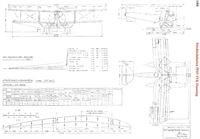
Описание
Страна: Германия
Год: 1918
Варианты
- Friedrichshafen - FF19 - 1914 - Германия
- Friedrichshafen - FF29 - 1914 - Германия
- Friedrichshafen - FF33 - 1915 - Германия
- Friedrichshafen - FF39 - 1916 - Германия
- Friedrichshafen - FF49 - 1917 - Германия
- Friedrichshafen - FF59 - 1918 - Германия
- Friedrichshafen - FF67 - 1918 - Германия
- Friedrichshafen - FF71 - 1919 - Германия
- В.Обухович, А.Никифоров Самолеты Первой Мировой войны
- O.Thetford, P.Gray German Aircraft of the First World War (Putnam)
- J.Herris Friedrichshafen Aircraft of WWI (A Centennial Perspective on Great War Airplanes 21)
- Журнал Flight
-
O.Thetford, P.Gray - German Aircraft of the First World War /Putnam/
Friedrichshafen FF 59a
-
M.Dusing - German Aviation Industry in WWI. Volume 2 /Centennial Perspective/ (85)
Fdh FF59A (1918). The FF 59 was developed from the FF 49 and, like the latter, was a slightly larger version of the successful FF33 with a more powerful engine. The R.M.A. placed an order on August 27, 1917, and two examples were built with the navy numbers 1822 and 1823. Number 1822 was equipped with an "inverted", i.e. downward-set fin similar to the fin of the Hansa-Brandenburg W.12 in order to give the gunner a larger field of fire to the rear.
-
J.Herris - Friedrichshafen Aircraft of WWI /Centennial Perspective/ (21)
Marine Number 1822 was the first prototype FF59.The vertical tail surfaces were mounted under the tailplane to maximize the observer's field of fire in a manner reminiscent of Brandenburg practice. (The Peter M. Bowers Collection/The Museum of Flight)
-
J.Herris - Friedrichshafen Aircraft of WWI /Centennial Perspective/ (21)
Fdh FF59C (1918). The deep-sea aircraft designed by engineer Grulich had two 200 hp Benz Bz.IV engines. However, the tests carried out as FF 59a were not satisfactory with this configuration, so that an additional fin supported by I-struts on the horizontal stabilizer was fitted to the rear of the fuselage of the naval number 1822. The additional stabilizing surfaces under the horizontal omitted stabilizer were on the aircraft now designated FF 59C. However, as the effect of the large rear firing area was lost again as a result of this rather steeply raised vertical stabilizer, it was decided to equip the aircraft with a conventional FF tailplane. A total of 20 aircraft of this type were delivered.
This photo shows Marine Number 1822 after the vertical tail surfaces were modified. Now the fin projects above the fuselage to improve flying qualities but compromising the observer's field of fire. -
O.Thetford, P.Gray - German Aircraft of the First World War /Putnam/
Friedrichshafen FF 59c
-
J.Herris - Friedrichshafen Aircraft of WWI /Centennial Perspective/ (21)
The FF59 was developed from the FF49 with particular attention to giving the observer the maximum field of fire.
-
Журнал - Flight за 1919 г.
F.F. 59B
-
J.Herris - Friedrichshafen Aircraft of WWI /Centennial Perspective/ (21)
Friedrichshafen FF 59 SVK Drawing
-
J.Herris - Friedrichshafen Aircraft of WWI /Centennial Perspective/ (21)
Friedrichshafen FF 59 SVK Control Drawing
В.Обухович, А.Никифоров Самолеты Первой Мировой войны
В середине 1918 г. на базе FF 39 был создан еще один самолет - FF 59с. Новая машина имела измененное хвостовое оперение. Коробка крыльев стала безрасчалочной. Межкрыльевые стойки были сдвинуты к концам крыльев для того, чтобы была возможность вести огонь из турельного пулемета. Кроме того, было изготовлено по одному самолету модификаций FF 59а и FF 59b, которые отличались хвостовым оперением.
Описание:









